Eco’s Elders of Zion
In Umberto Eco’s new novel The Prague Cemetery, the high-ranking tsarist police agent Peter Rachkovsky explains why he commissioned The Protocols of the Elders of Zion from a forger named Simone Simonini:
Hatred is the true primordial passion. It is love that’s abnormal . . . You don’t love someone for your whole life . . . but you can hate someone for your whole life-provided he’s always there to keep your hatred alive . . . Hatred warms the heart.
Today, few people in Europe and America have ever heard of The Protocols, but when the French scholar Henri Rollin studied it in 1939, he deemed it the world’s most widely circulated book after the Bible. First published in full in 1905, The Protocols of the Elders of Zion purports to be a transcript of a secret meeting of rabbis plotting to control the world. It begins with a chief rabbi’s cynical avowals:
Having set aside all fine phrases, we will speak of the meaning of every thought; by comparisons and deductions, we will illuminate circumstances. And so I will formulate our system from our point of view and that of the goyim.
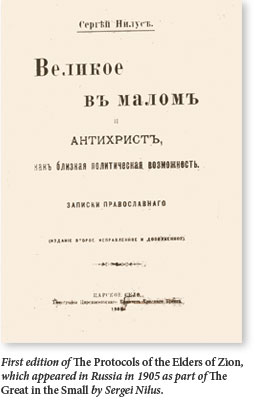
People want the illusion of freedom, so the Jews will use liberal impulses to undermine all present authority. Then they will exploit the very same impulses to establish Jewish rule by calling it true freedom. “The idea of freedom,” the rabbi explains, “cannot be realized because no one knows how to make reasonable use of it.” Accordingly, Jews must use every means to accomplish their end, because “according to the laws of nature, right lies in might . . . From temporary evil to which we are now obliged to have recourse will emerge the good of an unshakable government, which will reinstate the orderly functioning . . . now interrupted by liberalism. The end justifies the means.”
Where do these Machiavellian views come from? They seem to echo those of Dostoevsky’s “Grand Inquisitor,” whose unshakeable government was based on the recognition that people fear freedom, with all the uncertainty, anxiety, and guilt it entails, and would willingly surrender it to rulers who will provide security, as long as they claim to do so in the name of a higher freedom.
The publisher of the first complete version of The Protocols, the Russian theologian Sergei Nilus, found this portrait of human nature convincing and accepted the text as genuine. Indeed, he marveled at the providential miracle that brought the The Protocols to light, against the will of the powerful Elders of Zion. “In what way these documents, constituting the Holy of Holies of the hopes of Israel, the age-old mystery of its leaders, reached the general mass of the uninitiated has not been ascertained,” he admitted.
That so few people paid attention to The Protocols was due (of course) to Jewish control of the world press. But Nilus needn’t have worried. First employed to blame Russian radical activity on the Jews, The Protocols was soon translated into English, French, German, Polish, Spanish, and Arabic. Brought to Germany by Alfred Rosenberg, an ethnic German from the Russian empire, it inspired Hitler, who praised it in Mein Kampf. Its account of a Jewish world conspiracy has shaped anti-Semitic propaganda ever since.
From the beginning, it was suspected of being a forgery. And from the beginning its defenders replied that (a) it was genuine, because all the evidence of forgery was itself forged by the Jews, and (b) even if fake, it correctly describes the Jewish conspiracy, since history has unfolded just as the Elders of Zion forecast. As Nilus argued, if The Protocols is a forgery, then it testifies all the more strongly to the power of truth to reveal itself in strange ways. “Didn’t Balaam’s ass prophesy?”
In 1920, the London Times posed a far more unsettling question inspired by The Protocols: “Have we, by straining every fibre of our national body, escaped a ‘Pax Germanica,’ only to fall into a ‘Pax Judaica’?” But in 1921, the Times recanted. A Russian émigré provided its correspondent in Constantinople, Philip Graves, with the book from which many of the Elders’ speeches had been lifted, almost word for word. A forgotten French liberal, Maurice Joly, had composed a Dialogue in Hell between Machiavelli and Montesquieu in order to discredit Napoleon III by revealing, through the mouth of Machiavelli, the emperor’s cynical methods for manipulating the masses. Whoever forged The Protocols had evidently given Machiavelli’s comments to the Elders of Zion, merely substituting “goyim” for “people” and “revolution” for “coup d’état” to serve Russian anti-Semitic purposes. So close are passages from the two works that it is impossible to believe in the authenticity of these supposed transcripts.
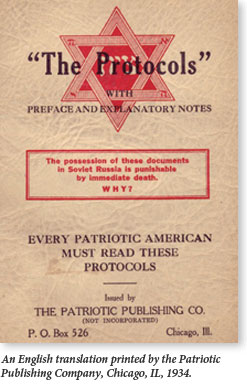
Well, not quite impossible. Today, The Protocols still commands allegiance in some Russian circles. I would venture that to narrate the history of Russian thought without mentioning anti-Jewish philosophies—as is usually done—is to omit a key part of Russian intellectual life.
In recent years, The Protocols has enjoyed the greatest success in the Middle East. Endorsed by Nasser and the Saudi Ministry of Education, it is cited as genuine in the charter of Hamas. A textbook used by schools under the Palestinian Authority described The Protocols as the authentic record of secret meetings of the First Zionist Congress. In the last decade, two popular TV series, one produced in Egypt and another in Syria, have been based on it. In America, The Protocols—once Henry Ford apologized for having circulated it—survived only among a few tiny fringe groups, but in the Middle East it has gone mainstream. Recently, Islamists seeking to discredit Shiites have produced a Protocols of the Elders of Qom. In the original Protocols, the Masons serve as the Zionist front, while in Iran, that role has been ascribed to the Baha’is.
n describing the early evolution of literature detailing a worldwide Jewish conspiracy, Eco’s novel closely follows the story told by Norman Cohn in his classic history, Warrant for Genocide. Cohn’s narrative begins with one Abbé Barruel. According to Barruel, the Templars had not been destroyed in 1314 but had survived underground, had given birth to various front organizations like the Freemasons and Illuminati, which had in turn inspired Voltaire, Condorcet, and other enlightenment thinkers, and had at last engendered the Jacobins. Now, in the 19th century, they were poised on the threshold of world domination. As it happens, Barruel received a letter from an otherwise unknown army officer, J. B. Simonini, who endorsed his theories but pointed out that the real force behind all these conspiracies was “the Judaic sect.” Barruel was eventually convinced.
In The Prague Cemetery, Captain Simonini expounds his theories to his (fictitious) grandson, who becomes its hero, or anti-hero. This Simonini also acquires from his grandfather his spiteful disposition and his love of describing, as well as eating, gourmet food. A lot—too much—of this novel consists of menus and recipes. And Simonini also learns to cook up all sorts of fake documents, at first to steal inheritances and later as an operative for various secret police forces. Eco explains that he made this forger, murderer, and eventual author of The Protocols, “the most cynical and disagreeable in all the history of literature,” as well as the only wholly fictitious character in his novel. Disagreeable he is, but Eco’s boast betrays his own literary megalomania. A truly evil figure would have to be psychologically plausible, and Simonini’s diaries and conversations read less like life than a piece of bad Victorian fiction.
As Eco knows perhaps better than anyone, the real history of The Protocols is in fact closely intertwined with bad fiction. In 1868, a German author, Hermann Goedsche, writing under an English pseudonym, Sir John Retcliffe, published the novel Biarritz, which contained a chapter entitled “In the Jewish Cemetery in Prague” describing a secret meeting of rabbis plotting to take over the world. Tombstones, incantations, mysterious flames: every cliché of Gothic fiction haunts this meeting of evil Jews who address each other as “sons of the Golden Calf.” By 1872, this chapter had appeared in Russian in St. Petersburg, presented as a fiction based on fact. It was published again and again in Russia and then in France as an actual document.
Eco multiplies the peculiarity of reframing fiction as fact by having Goedsche imagine that he is stealing a secret factual document and selling it as sensationalist fiction for a greater reward. But that factual document is actually a forgery produced by Simonini, who is in turn relying on a novel by Dumas in which Jesuits conspire in a cemetery. When Simonini tries to sell his forgery to someone else, he is falsely exposed as a plagiarist copying from Goedsche’s novel! Time and again, Eco plays on the idea of a fictitious fiction plagiarized from a forgery based on a fiction covertly indebted to other factual or fictitious documents. The reader’s head spins from all the postmodern play representing something that in part really happened.
Except for Simonini, everyone mentioned in this lurid tale about forgers, murderers, secret police, spies, double agents, revolutionaries, Masons, Jesuits, and Satanists is, amazingly enough, real. Eco has also added to Cohn’s account his own discovery that novels by Alexander Dumas and Eugene Sue about Jesuits served as an important source for Goedsche. To supplement the feel of bad Victorian fiction, Eco borrows dozens of period illustrations (most of them from his own private collection). As a result, The Prague Cemetery ironically conjures the feel of lurid books of the time. But doesn’t all this meta-fictional play get in the way of Eco’s serious point about a deadly forgery?
Eco appears to want it both ways: to have his illusion and expose it too. On the one hand, he obviously enjoys all the self-referential semiotic play, but on the other still wants to insist that there really is such a thing as truth and falsehood. As he has recently written, “I am not what in certain U.S. academic departments is derogatorily called a ‘textualist’—someone who believes (as some deconstructionists do) that there are no facts but only interpretations.” In spite of all his postmodern legerdemain, therefore, he includes a preface and afterword warning us to take the story completely seriously. Or almost completely: in a partial reversal of this reversal, he entitles this afterword “Useless Learned Explanations.” The result is not entirely coherent. Eco is always straining after effect, while telling us—for effect?—that all this is not just for effect.
Still worse, the made-up parts about Simonini’s psychic disturbance read like a bad imitation of a Hollywood rendition of a psychoanalytic case study. It seems that Simonini has been suffering from an identity crisis and is unsure whether a certain Abbé Dalla Piccola, who seems to have access to his apartment and memories, is really himself. Having met an Austrian Jew named Froïde, or something, Simonini decides to recall and record as much as he can about his past. He hopes this sort of therapy will provide a self-conducted talking—or rather, writing—cure. Readers are obligated to negotiate an often-confused record of remembrance, with some passages by Simonini, some by Dalla Piccola, and some by an all-too-postmodern “Narrator.” At last the celibate Simonini, for whom food is the sole source of physical pleasure, discovers that his trauma has been caused by a sexual encounter. This is mechanical plotting and the shallow end of depth psychology.
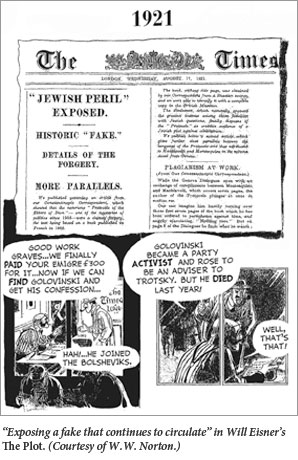
To be sure, Freud’s conspiratorial theory of self, in which hidden agents manipulate our behavior against our will, fits the novel’s conspiratorial story. But that is not necessarily a good thing, since Eco’s tale never escapes the subterranean world of plots and counterplots. Rather than offering an alternative to conspiratorial thinking, Eco simply adds one more conspiracy. Or rather two: both the subconscious war on Simonini’s self and a new political plot. In addition to the nefarious machinations of Jesuits, Masons, and Illuminati, we now have those of anti-Semites. It is they, not the Zionists, who use the Masons as a front and secretly cause one major historical event after another. Readers discover a new darkness, but are never shown daylight.
The Prague Cemetery, Eco seems to hope, will inoculate a wide readership against The Protocols. In this respect, it resembles the great comic book writer Will Eisner’s graphic novel The Plot: The Secret Story of the Protocols of the Elders of Zion, except that Eco’s story ends with the forging of The Protocols while Eisner took the narrative into the 21st century. In fact, Eco wrote an introduction to Eisner’s work that begins: “The most extraordinary aspect of The Protocols of the Elders of Zion is not so much the history of its inception as that of its reception.” Evidently, The Prague Cemetery represents the opposite thought. Or is it that the reception history does not offer so many postmodern possibilities?
Eisner’s main question was “how can one explain resilience [of The Protocols] against all evidence, and the perverse appeal that this book continues to exercise?” In facing this conundrum, Eco, Eisner, and Norman Cohn all fall victim to the same fallacy. Because they cannot imagine themselves taking the book seriously, they assume no one else with a brain ever could. In their view, anyone who accepts The Protocols, or at least its account of history, must be either an idiot, an ignoramus, or subject to delusions explicable only in psychoanalytic terms. (This is Cohn’s basic historical explanation, personified by Eco in the character of Simonini).
If only it were so! But to assume that no intelligent person could disagree with one’s own views is to fail the historian’s fundamental test: imagining how people unlike oneself think. Could it really be that the Middle Eastern intelligentsia consists mostly of morons? Why has the worldview of The Protocols affected so many Russian and German thinkers?
Liberal souls, like Eco, Eisner, and Cohn, find it unbelievable that anyone could reject liberal democracy, except those who fear the forces of modernity. Eco’s hero describes how people accept beliefs “as an explanation for their failure. It was someone else . . . who planned your ruin.” Eisner has a character attribute them to the need to justify shameful behavior “and of course, their reaction to social change!”
One would think we had not just experienced the 20th century, when so many intellectuals and entire countries knowingly accepted one or another form of totalitarianism. Surely the Leninists, Stalinists, Trotskyites, and Maoists had reasons, not just irrational fears, for rejecting liberalism. And for that matter, is fear of modernity necessarily irrational? A believer in Islam who has contemplated the withering of Christian faith in Europe might well decide to embrace anti-democratic and anti-modern views.
In one passage of The Prague Cemetery, Eco dwells on Dostoevsky’s anti-Semitism, which at its worst would have pleased a Nazi. I imagine most people would agree that, whatever his failings, Dostoevsky was neither uneducated nor stupid. As it happens, Dostoevsky addressed the very question Cohn and Eco cannot answer. In an article objecting to an attack on Russia’s radical youth as idle, undeveloped, non-studious rowdies, Dostoevsky wrote that, on the contrary, even among revolutionaries and terrorists one often finds well-educated and noble souls. I know so, he explains, because I was once one of them.
I also stood on the scaffold condemned to death, and I assure you that I stood in the company of educated people . . . Therein lies the real horror. One can commit the foulest and most villainous acts without being in the least a villain! . . . The possibility of considering oneself, and sometimes even being, in fact, an honorable person while committing obvious and undeniable villainy that—that is our whole affliction!
Dostoevsky’s own anti-Semitic writings prove the point.
I do not know how to explain why people continue to believe in the international Jewish conspiracy. But I do know that there is something inherently suspect in attributing others’ beliefs to stupidity, lack of worldly success, or mental imbalance. For in leaving us ignorant of how such believers actually think, it renders us defenseless before them. It is also a failure of the imagination.
Suggested Reading
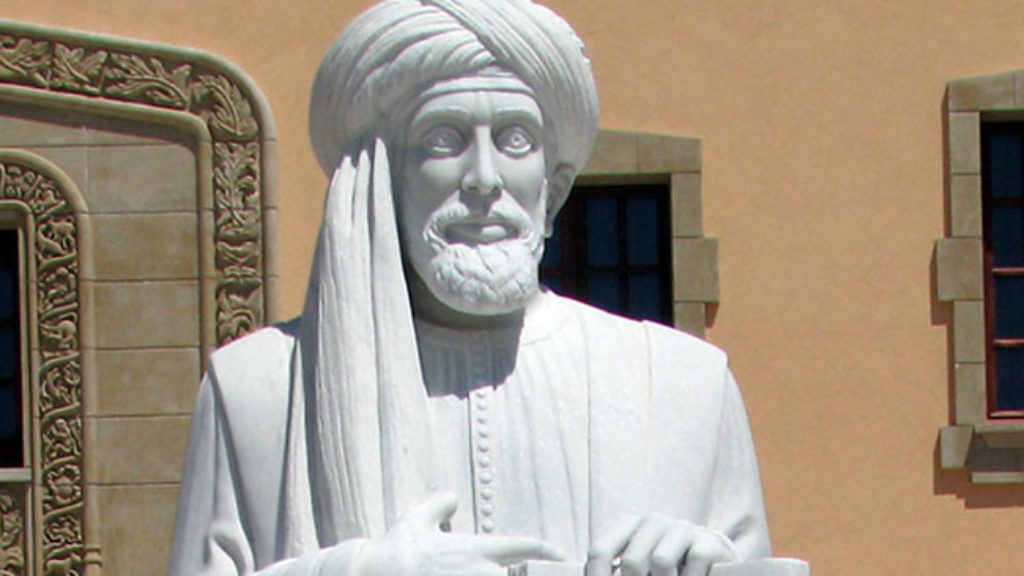
The Ubiquitous Gabirol
Solomon ibn Gabirol plunges into poetry, writes S. Y. Agnon, medabek atzmo be-charuz: glued to his craft, beading words with devotion.

Our Lady in Tehran
In Tehran, the Mossad has orchestrated a complex and brazen operation as part of a last-ditch effort to cut the capital’s power supply so that the Israeli Air Force can take out Iran’s nuclear program
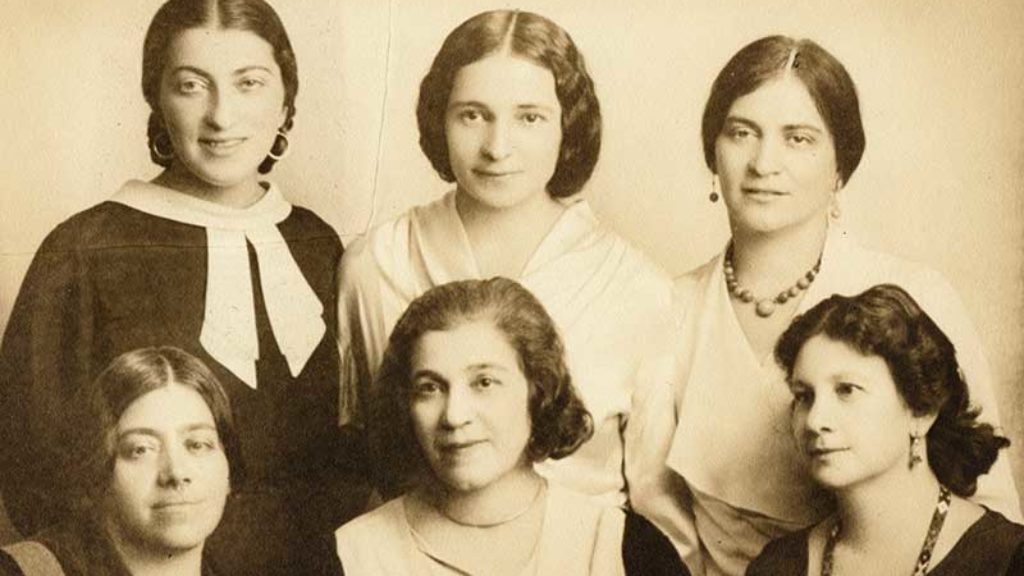
Funny How a Poem Can Get Under Your Skin
On Celia Dropkin’s avant-garde Yiddish break-up poem and a political insight.
The Great Gaon of Italian Art
Berenson’s teacher Charles Eliot Norton dismissively dubbed Berenson's method the “ear and toenail school,” but Berenson employed the technique in his first book to great effect.
Comments
You must log in to comment Log In